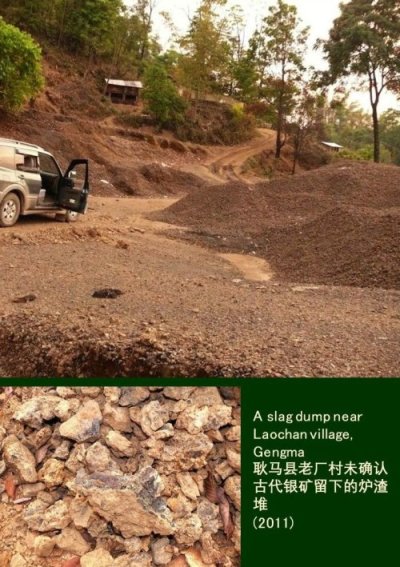Mining and metallurgy in Southwest China, 14th to 19th century: Research in archaeo-metallurgy and historical geography

This project is about the history of mineral exploitation in the southeastern crunch zone of the Himalayan Plateau. Yunnan province occupies most of this region, but it continues into adjoining highland areas of northeastern Myanmar and northern Vietnam, as well as into western Sichuan and northwestern Guizhou. For reasons of research logistics, this research project largely focuses on Yunnan.
The bronze-age cultures of the region are famous for their great drums made from cast bronze, and the ancient kingdoms of Dian, Nanzhao and Dali are well-known, especially for their metal objects. The more recent history of mining and metallurgy, however, is far less clear. Supposed or actual riches of gold and silver in the Dali kingdom are suspected to have been one of the reasons for the Mongol invasion that ended with the conquest of Dali in 1253. Records of the Mongol Yuan dynasty (1279-1368) reflect intensive silver exploitation, yet the sites are unknown. For the Ming period (1368-1644), some copper and tin mining, as well as some twenty silver mines appear in the records, but the overall scope was small to negligible, if surviving tax revenues are systematic and representative of actual exploitations. Qing (1644-1911) records contain more names of sites and occasional details, allowing the identification of roughly 200 mines. As copper mines received special government attention due to the importance of copper for coinage from the early 18th century onwards, official records focus on this sector, reflecting considerable development of overall outputs as well as in the number of exploited sites. At the same time, iron, silver, zinc and tin mining appears to have remained on a modest level.
However, early 20th century materials provide evidence that a large number of historic mines were missing in the official records of the imperial period. Surveys of mineral deposits in Yunnan province dating between 1908 and 1949 record over 2000 sites exploited in the past. Although the scale and period of exploitation is uncertain for most mines, their numbers reflect an omission of 90% of all sites in the available historic sources. Moreover, specific aspects of mining and metallurgical technologies remain insufficiently understood. Thus, surface mining, small open pits and intentionally flushed out gullies, pit mines and the construction of level or inclining galleries may have been employed in succession or concurrently. Smelting technologies become historically visible only from the early nineteenth century, when surprisingly large furnaces were employed in most processes, with numerous technological details and transformations hitherto not understood.
The subject of this project is the systematic exploration of the hitherto under-researched period and region; and the primary aim is the basic research in geo-locating, identifying, surveying and assessing sites, and the analysis of results as a basis for a systematic reconstruction of the region’s mining and metallurgical history. The research focuses on the Ming and Qing periods or the five centuries before the industrial transformation, roughly 1350-1850. For logistic reasons, the main geographic area is Yunnan province. There are some reasons of consistent materials that we can use in our preparatory work, but the main reason is simply that Yunnan province alone offers a lot of ground to cover. The province’s area is 394.100 sqkm, roughly equal to Germany (357.578 sqkm) and the Netherlands (41.543 sqkm) together. We carry out as much fieldwork as we possibly can, yet we can only cover a small proportion of the region.
This project builds on the synergies of the cooperation partners. Yang Yuda’s and Nanny Kim’s project on silver mines in the region established the usefulness of fieldwork and historical geography in researching a largely non-liturgical topic through remains oral histories, and spatial contexts (2009-2014, as DFG project 2015-2018). Li Xiaocen and his team possess the metallurgical expertise possess the means of analysing and interpreting sites and specimens and thus to reconstruct historical technologies and transformations. Dagmar Schäfer contributes the wider perspective of long-durational patterns in knowledge and practice.
It employs inter-disciplinary approaches to overcome obstacles to research. The geo-location of sites employs historical geography based on a wide range of data, with a specific focus on clusters of place names that we have developed for the area. Geo-location permits targeted fieldwork for the recording of material remains and oral traditions as well as for sampling ores, slags and other remains. Material analyses on the samples provides scientific data on historical technologies, while GIS analyses offer spatial contexts of surveyed sites in their present and historic landscapes.
The purpose of this project page is the presentation of sites of mining and metallurgy, specifically on the sites visited during fieldwork by project members and cooperation partners. The main content therefore is the collected materials on individual sites or clusters of sites that consist of an analysis of the written materials, field reports, maps, photographs and interpretations of results. These are materials from ongoing research, with some rough edges, but full of new materials on known and formerly unknown sites. We should add that most this work is far from glamorous and depends on the help of local informants, villagers, local officials, and local mining companies. The pages on the sites are the core research results of this project and strictly adhere to scientific standards. All references are found in the bibliography. You can access the pages on each site by links from the list of visited sites. (A map for directly assessing the materials on each site is in the making.)
If you are interested in locating the sites in their regional context of minerals and their exploitation history, you might consult the background pages on the metals and minerals and their role in human history. I should point out these pages are not “scientific” but providing a cursory introduction based my or the respective author’s general knowledge only.

